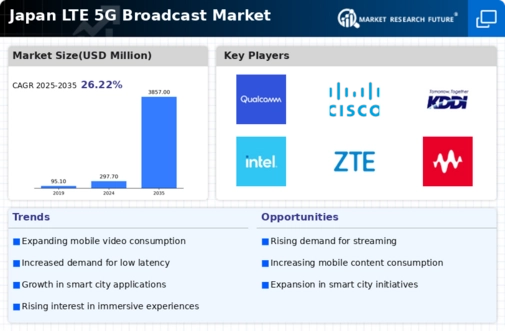Increased Focus on Mobile Gaming
The lte 5g-broadcast market in Japan is witnessing a growing emphasis on mobile gaming, which is becoming a significant driver of content consumption. With the advent of 5G technology, mobile gaming experiences are expected to improve dramatically, offering lower latency and higher data speeds. As of 2025, the mobile gaming market in Japan is projected to reach approximately $3 billion, indicating a robust appetite for interactive content. This trend presents an opportunity for the lte 5g-broadcast market industry to develop specialized broadcasting services tailored to gamers. By leveraging 5G capabilities, broadcasters can deliver real-time gaming content, live events, and interactive experiences, thereby attracting a younger demographic. The integration of gaming with broadcasting services may also lead to innovative advertising models, further enhancing revenue streams within the lte 5g-broadcast market.
Expansion of Smart Device Ecosystem
The proliferation of smart devices in Japan significantly influences the lte 5g-broadcast market. With an increasing number of households adopting smart TVs, smartphones, and tablets, the potential audience for broadcast content expands. As of 2025, it is estimated that over 80% of households in Japan own at least one smart device, creating a fertile ground for the lte 5g-broadcast market industry to thrive. This ecosystem allows for seamless integration of broadcast services, enabling users to access content anytime and anywhere. Moreover, the rise of Internet of Things (IoT) devices further enhances the connectivity and interactivity of broadcast services, providing opportunities for personalized content delivery. Consequently, the lte 5g-broadcast market is likely to see increased engagement and viewership, as consumers become more accustomed to accessing content through their smart devices.
Rising Demand for High-Quality Content
The lte 5g-broadcast market in Japan experiences a notable surge in demand for high-quality content. As consumers increasingly seek superior viewing experiences, broadcasters are compelled to enhance their offerings. This trend is reflected in the growing investment in 4K and 8K content production, which is expected to reach approximately $1.5 billion by 2026. The lte 5g-broadcast market industry is thus positioned to benefit from this shift, as 5G technology facilitates the efficient delivery of high-definition content to a larger audience. Furthermore, the integration of advanced compression techniques allows for the transmission of high-quality video without significant bandwidth consumption, making it a viable option for broadcasters aiming to attract viewers. This demand for high-quality content is likely to drive innovation and competition within the lte 5g-broadcast market, ultimately enhancing consumer satisfaction.
Adoption of Advanced Broadcasting Technologies
The lte 5g-broadcast market is significantly influenced by the adoption of advanced broadcasting technologies in Japan. Innovations such as cloud-based broadcasting and edge computing are transforming the way content is delivered to consumers. These technologies enable broadcasters to optimize their operations, reduce latency, and enhance the overall viewing experience. As of 2025, it is estimated that over 60% of broadcasters in Japan are investing in cloud-based solutions, indicating a shift towards more flexible and scalable broadcasting models. The lte 5g-broadcast market industry stands to benefit from these advancements, as they allow for more efficient content distribution and improved service reliability. Additionally, the integration of artificial intelligence in content curation and delivery may further enhance user engagement, making the lte 5g-broadcast market a dynamic and evolving sector.
Government Initiatives for Spectrum Allocation
The Japanese government plays a crucial role in shaping the lte 5g-broadcast market through its initiatives for spectrum allocation. By designating specific frequency bands for 5G broadcasting, the government aims to facilitate the deployment of advanced broadcasting technologies. This strategic move is expected to enhance the efficiency of spectrum usage, allowing broadcasters to deliver high-quality content to a wider audience. As of 2025, the government has allocated approximately 100 MHz of spectrum for 5G broadcasting, which is anticipated to support the growth of the lte 5g-broadcast market industry. Furthermore, these initiatives are likely to encourage investment in infrastructure development, as broadcasters seek to capitalize on the newly available spectrum. This proactive approach by the government may lead to a more competitive landscape, fostering innovation and improving service delivery in the lte 5g-broadcast market.
























Leave a Comment